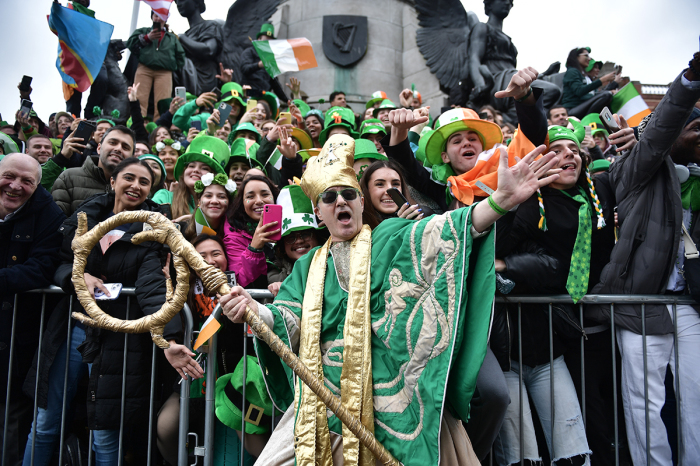Christian author challenges commercialized image of St. Patrick with prayer devotional

In a culture awash with symbols of luck and celebration associated with St. Patrick’s Day, an author is on a mission to shed light on the lesser-known aspects of Ireland’s patron saint, focusing on his profound spiritual legacy and prayer life and how it applies to Christians today.
In an interview with The Christian Post, Aaron Burns, author of Praying with Saint Patrick, delved into the little-known story of St. Patrick, a figure far removed from the commercialized imagery of four-leaf clovers and green beer.
His interest in St. Patrick's life, he said, was piqued by the saint's incredible journey from a victim of human trafficking to a missionary who profoundly impacted Ireland and Christianity.
“Young Patrick said he wanted nothing to do with prayer, or religion or any of that nonsense until he's kidnapped by Irish pirates at the age of 15, and then is taken over to Ireland,” Burns said.
“He spent six years as a slave, tending sheep in the mountains of Ireland. And he tells us that it's there that he began to pray, bringing to mind the things that he'd been taught as a boy. His faith became real to him through this incredible suffering and trials. And then, God miraculously allows him to escape, and God says, ‘Now that you're home, I'm calling you to take the love of Christ to the people who had slaved you.’ And that's his journey. Watching his heart be so transformed by God's love, and then taking that love and giving it back to the people who enslaved them is very powerful and inspiring to me.”

In Praying with Saint Patrick, Burns, who also directed the Great American Pure Flix film, “Birthright Outlaw,” aims to rediscover the historic and spiritual legacy of one of Christianity's most well-known figures while inviting readers to explore a deeper, prayerful connection with their faith.
The devotional is structured around 40 prayers that reflect various stages of St. Patrick's life, from his youth, through his captivity and slavery in Ireland, to his later years as a missionary and bishop. Burns told CP he aimed to provide readers with a narrative that blends historical context with personal reflection, allowing them to connect with Patrick's journey and apply his prayerful mindset to their own lives.
"Prayer is such a challenging thing for modern, Western Americans," Burns said.
He pointed to a significant issue in contemporary society: the separation of spiritual life from physical life, creating a vast gap between the connection to God and daily existence. This division, according to Burns, represents a "huge danger" as it leads to a disconnection from the spiritual dimensions of life.
But in St. Patrick's era, the boundary between the spiritual and the physical was much thinner, with the natural world imbued with a sense of the supernatural.
"In Patrick's day, the people of Ireland lived in fear of nature because there was such a demonic presence, and their religion, that shapeshifters and werewolves and real demonic possession and all these things were very prevalent," Burns explained. This closeness to the spiritual world made prayer a vital, daily practice for protection, guidance and support, he said.
One of the ways Burns encourages this reconnection is through the practice of praying St. Patrick's famous "Breastplate" prayer, a powerful invocation for protection and strength drawn from the saint's own words.
"I've prayed this prayer on many mornings," Burns said.
In his research, Burns was particularly moved by two prayer requests from St. Patrick that shaped the book's direction. The first was Patrick's hope for spiritual descendants, a wish that was fulfilled through the saint's lasting influence on Irish Christianity and beyond.
“He prayed, ‘I pray that I would be able to have spiritual descendants. I never had kids of my own, but I would love to leave a spiritual legacy that people would follow Christ the way that I did,'" Burns shared. "And God answered that prayer with a resounding ‘yes.’ In his lifetime, we see the end of the human trafficking that Patrick himself was a victim of; we see the end of child sacrifice. The poor, underprivileged and enslaved resonated with the message of the Gospel and God's love that was shared with them. And the natural organic church just blossoms in Ireland, and over the next 300 years.”
The second prayer request, Burns said, was Patrick's desire for his legacy to point people toward Christ rather than the commercialized and politicized images that prevail today. That prayer, he said, has yet to be fulfilled.
“He says, ‘I pray that anyone who hears of St. Patrick wouldn't think of me, but think of Christ and what God has done,’” Burns said. “That prayer has not been answered yet. ... So part of the inspiration for me in writing this book was to be able to be a small part of answering this 1,500-year-old prayer to share the Good News of what God has done and to inspire us to live like Patrick and say, ‘Where's my Ireland? What is God calling me to do?’”
Reflecting on the commercialization of St. Patrick's Day, Burns discussed the historic journey from the saint's original ministry to today's largely secular celebrations. He lamented the loss of the true essence of St. Patrick's legacy, overshadowed by commercial and political interests over the centuries.
“He was a follower of Christ and was sanctified through his life,” he said. “But in his letters, you'll discover a very real man who talks about, even in his old age, his daily battle against temptation and sin. He talks about the great sins that he committed in his youth and how he's still wrestling with those, and wrestling with betrayal in temptation, and discouragement and frustration, and seasons of waiting, and all of these things.
He is so much more complex and so much more real than the stained glass window, perfect saint. That wasn’t him at all. I think the transformative power of God that was unleashed in Ireland in Patrick's time became something that politicians and even, later, church leaders looked back on and wanted to tap into.”
Still, the author said St. Patrick would have mixed feelings about his modern legacy, appreciating the celebration of God's work in Ireland but urging contemporary believers to remember the deep faith, prayer and miracles that marked his life and mission.
“He would be thrilled with the fact that people are celebrating what God did in Ireland,” Burns said. “He isn't a stodgy, stuffy guy; he would have fun at a party, he would love to go to St. Patrick's Day party, I'll tell you that. But he would be going around telling people, ‘Look at the prayers that God answered. Look at the lives that were transformed. Look at the slaves that were set free. Look at these poor women who moved from a place of abject poverty and slavery into freedom in Christ.' And he would be telling you stories of answered prayers and miracles and wanting you to be encouraged."
As nations celebrate St. Patrick’s Day, Burns said he hopes his devotional offers a timely reminder of the power of faith and the transformative potential of prayer, urging believers to reflect on the purpose behind their celebrations and to rediscover the spiritual legacy of one of Christianity’s most enduring figures.
“It's a gift to your faith to see someone who is so in love with Jesus, who was so in love with the people of his day, that he would sacrifice everything for them,” Burns said. “Patrick was just 400 years after the time of Jesus, and we’re still talking about him 2,000 plus years later. His faith is so real and relevant. He is one of those markers along the way of the transformative power of the Gospel and of what God can do through us when we invite him to.”
Leah M. Klett is a reporter for The Christian Post. She can be reached at: leah.klett@christianpost.com




























